3D motion capture technology revolutionizes dance choreography by accurately recording and analyzing dancers’ movements, which helps choreographers refine routines and enhance performances. By capturing the nuances of motion, this technology not only improves audience engagement but also provides valuable insights for dancers, enriching their artistic expression and educational experiences.
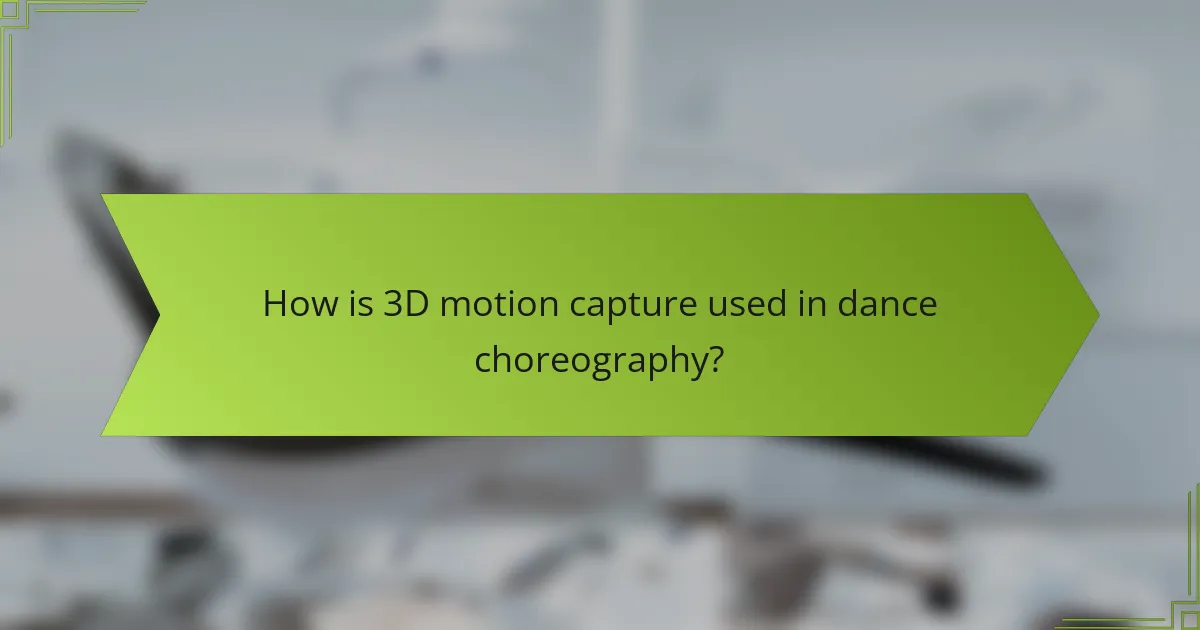
How is 3D motion capture used in dance choreography?
3D motion capture is utilized in dance choreography to accurately record and analyze dancers’ movements, enabling choreographers to refine their routines and enhance performances. This technology captures the nuances of motion, allowing for detailed feedback and creative exploration.
Real-time feedback for dancers
Real-time feedback is a crucial aspect of 3D motion capture in dance. Dancers can see their movements displayed on a screen immediately after performing, which helps them understand their body mechanics and make adjustments on the spot. This instant analysis can lead to improved technique and performance quality.
Using wearable sensors or cameras, the system tracks movements with high precision. Dancers can focus on specific areas, such as posture or timing, to enhance their overall execution. This immediate insight is particularly beneficial during rehearsals, where adjustments can be made quickly.
Integration with animation software
3D motion capture seamlessly integrates with animation software, allowing choreographers to visualize dance sequences in a digital format. This integration enables choreographers to create animated representations of their routines, which can be useful for pre-visualization and planning performances.
By exporting motion data into software like Maya or Blender, choreographers can manipulate and experiment with movements in a virtual environment. This capability not only aids in refining choreography but also facilitates collaboration with visual artists and filmmakers, expanding the creative possibilities for dance projects.
Enhancing creative expression
3D motion capture enhances creative expression by providing choreographers with new tools to explore movement. With the ability to analyze and manipulate motion data, artists can experiment with unconventional styles and techniques that may not be easily achievable through traditional methods.
This technology encourages innovation, as choreographers can blend dance with other art forms, such as visual effects or interactive media. By visualizing choreography in a 3D space, artists can push the boundaries of dance, creating immersive experiences that captivate audiences.
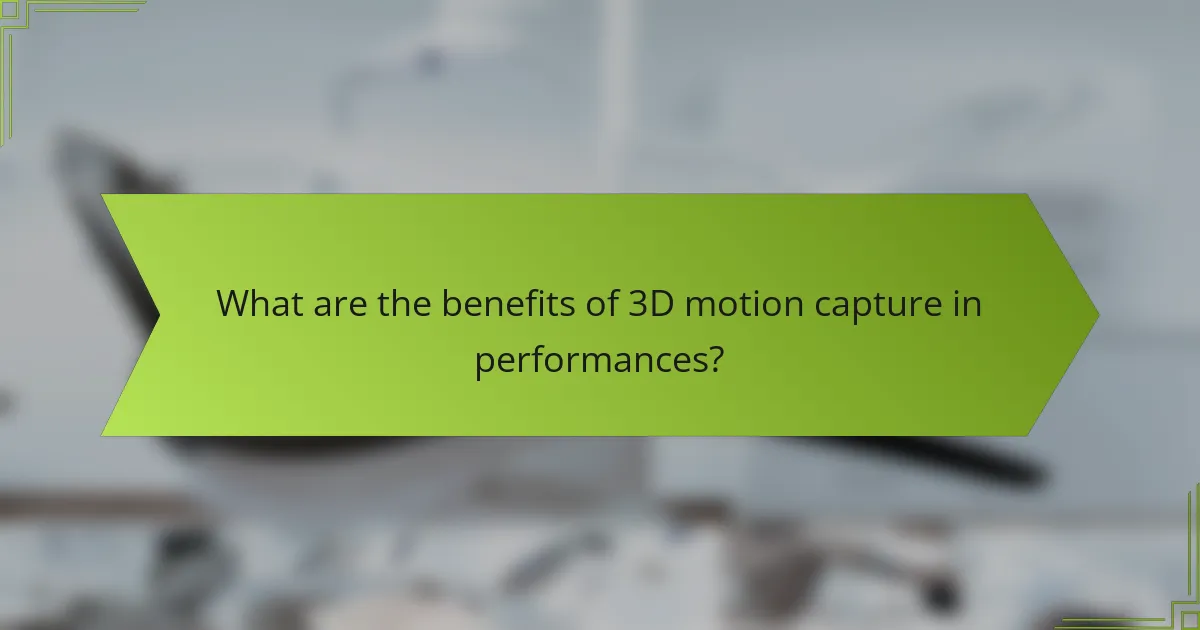
What are the benefits of 3D motion capture in performances?
3D motion capture enhances performances by providing detailed insights into movement, improving audience engagement, and allowing for versatile applications across various dance genres. This technology captures the nuances of choreography, enabling performers to refine their art and connect more deeply with their audience.
Improved audience engagement
3D motion capture can significantly elevate audience engagement by creating immersive experiences. By integrating motion capture data into live performances, choreographers can produce visually stunning displays that captivate viewers. For instance, real-time projections of dancers’ movements can enhance storytelling and emotional impact.
Additionally, interactive elements can be introduced, allowing audiences to influence the performance through their reactions. This level of engagement can lead to a more memorable experience, encouraging repeat attendance and word-of-mouth promotion.
Precision in movement analysis
Using 3D motion capture allows for precise analysis of dance movements, which is crucial for both performers and choreographers. This technology records data on speed, angles, and body positioning, enabling detailed feedback that can refine technique and improve overall performance quality.
For example, dancers can review their movements frame by frame, identifying areas for improvement. This level of scrutiny helps in correcting posture and enhancing synchronization, which is essential for group performances.
Versatile application across genres
3D motion capture is applicable across a wide range of dance genres, from ballet to hip-hop. Each genre can benefit from the technology’s ability to analyze and visualize movement, allowing for innovative choreography that pushes creative boundaries. For instance, contemporary dance can incorporate digital elements that respond to the dancers’ movements in real-time.
Moreover, this technology can be used in training programs, workshops, and performances, making it a valuable tool for both amateur and professional dancers. Its adaptability ensures that various styles can leverage the benefits of motion capture, enhancing the overall quality of dance as an art form.

How does 3D motion capture impact dance education?
3D motion capture significantly enhances dance education by providing precise visual feedback and immersive learning experiences. This technology allows students to analyze their movements in detail, leading to improved technique and performance.
Interactive learning experiences
3D motion capture creates interactive learning environments where students can engage with their movements in real-time. By using software that visualizes their dance steps, learners can instantly see how their body positions and timing affect their performance.
For example, a student can perform a routine while being recorded, and then review the captured data to identify areas for improvement. This immediate feedback loop fosters a deeper understanding of choreography and enhances retention of dance techniques.
Personalized feedback for students
With 3D motion capture, instructors can provide tailored feedback based on individual performance metrics. This technology allows teachers to pinpoint specific movements that need adjustment, offering personalized guidance that traditional methods may overlook.
Students can receive insights on posture, balance, and timing, enabling them to focus on their unique challenges. This personalized approach not only boosts confidence but also accelerates skill development, making it a valuable tool in dance education.
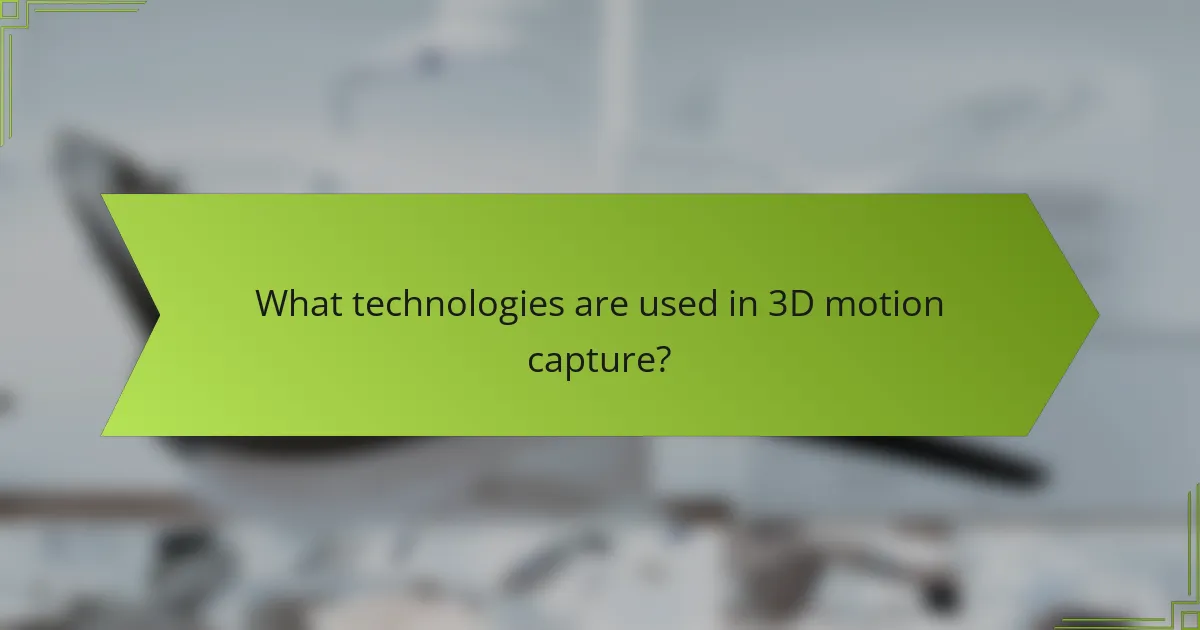
What technologies are used in 3D motion capture?
3D motion capture utilizes various technologies to accurately record and analyze human movement. The most common systems include optical motion capture, inertial motion capture, and markerless motion capture, each with distinct advantages and applications in fields like dance choreography and performance analysis.
Optical motion capture systems
Optical motion capture systems use cameras to track reflective markers placed on a performer’s body. These cameras capture the movement from multiple angles, allowing for precise three-dimensional data collection. This technology is widely used in film and video game production due to its high accuracy and detail.
However, setting up optical systems can be complex, requiring a controlled environment with sufficient lighting and unobstructed camera views. Common pitfalls include marker occlusion and the need for extensive calibration, which can be time-consuming.
Inertial motion capture devices
Inertial motion capture devices rely on sensors that measure acceleration and angular velocity to track movement. These sensors are typically worn on the body and do not require external cameras, making them more portable and easier to set up than optical systems.
While inertial systems are convenient and can be used in various environments, they may suffer from drift over time, leading to less accuracy in long-duration captures. They are ideal for applications where mobility is crucial, such as live performances or outdoor choreography.
Markerless motion capture solutions
Markerless motion capture solutions utilize advanced algorithms and machine learning to analyze video footage without the need for physical markers. This technology is gaining popularity due to its ease of use and ability to capture natural movement without the constraints of wearing sensors or markers.
Despite their advantages, markerless systems can be less accurate than optical or inertial methods, especially in complex movements or crowded environments. They are best suited for applications where quick setup and flexibility are prioritized, such as rehearsal spaces or interactive installations.
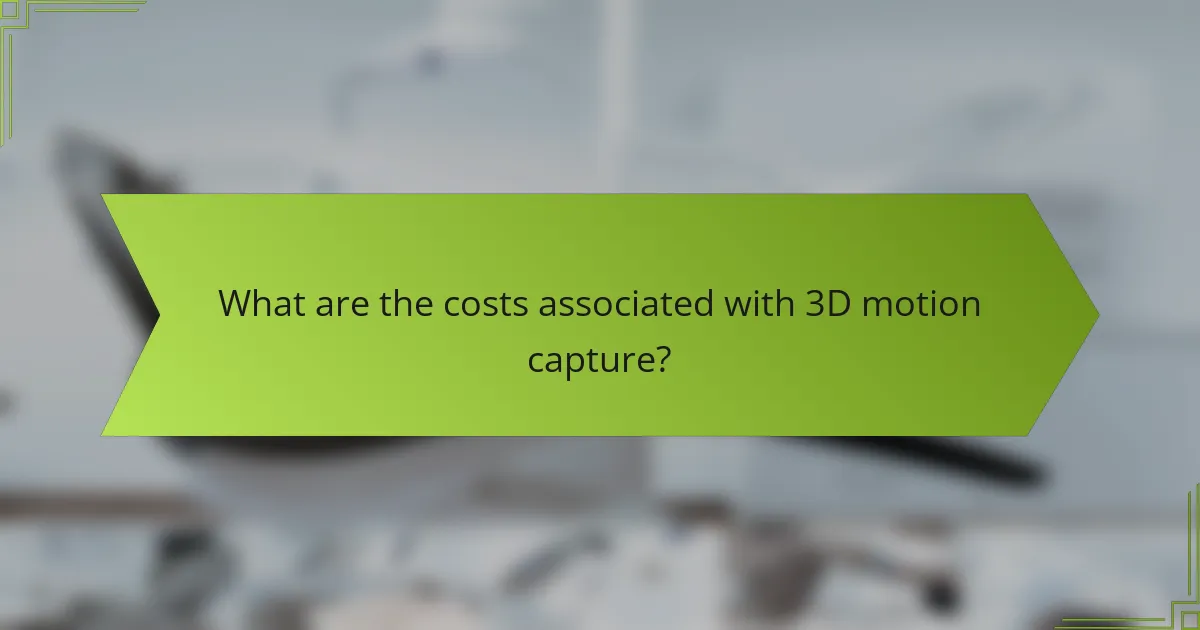
What are the costs associated with 3D motion capture?
The costs associated with 3D motion capture can vary widely based on factors such as equipment, software, and studio setup. Understanding these expenses is crucial for budgeting effectively for dance choreography and performance projects.
Equipment purchase and rental costs
Investing in 3D motion capture equipment can be significant, with prices for high-quality systems ranging from several thousand to tens of thousands of USD. For those not ready to purchase, rental options are available, typically costing a few hundred to several thousand USD per day, depending on the technology and duration of use.
When considering equipment, it’s essential to evaluate the type of capture system needed, such as optical or inertial systems, as each has different price points and capabilities. Additionally, factor in the costs of cameras, sensors, and any necessary accessories.
Software licensing fees
Software for processing and analyzing motion capture data often comes with licensing fees that can range from a few hundred to several thousand USD annually. Some software solutions offer tiered pricing based on features, so it’s important to choose one that aligns with your project’s specific needs.
Many software packages also provide trial versions, allowing you to test functionality before committing to a purchase. Be aware of potential additional costs for updates or technical support, which can add to the overall software expenditure.
Studio setup and operational expenses
Setting up a studio for 3D motion capture involves various operational costs, including space rental, utilities, and maintenance. Depending on location, studio rental can cost anywhere from a few hundred to several thousand USD per day, especially in urban areas.
Additionally, consider the costs of personnel, such as technicians or choreographers, who may need to be hired to operate the equipment and analyze the data. Budgeting for these operational expenses is vital to ensure a successful motion capture project.
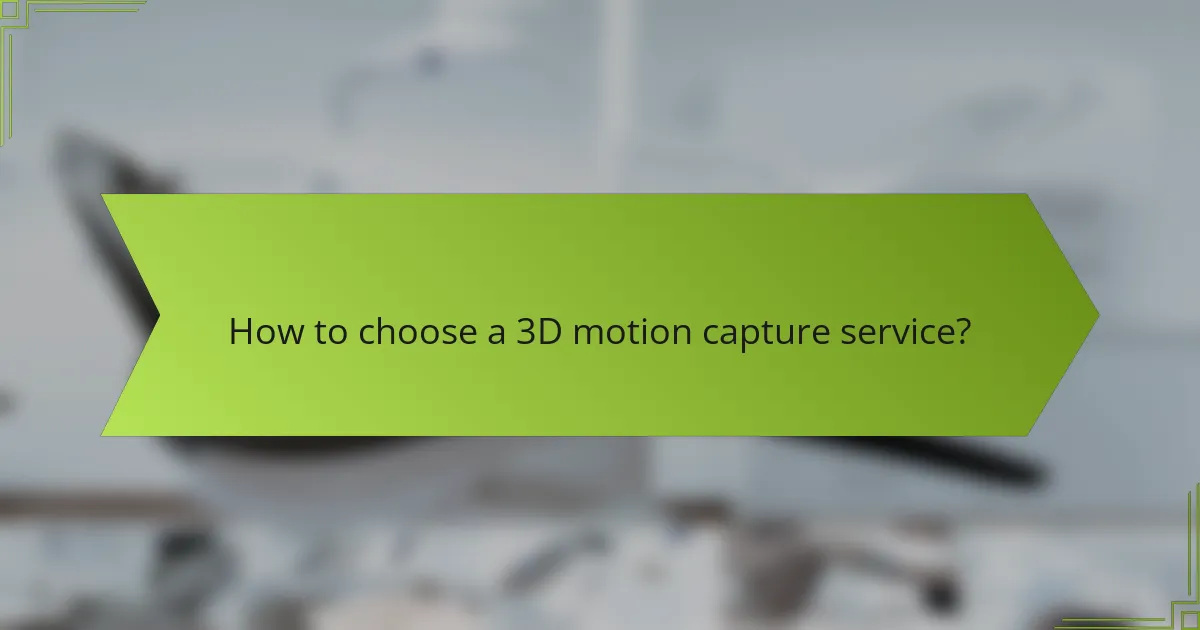
How to choose a 3D motion capture service?
Choosing a 3D motion capture service involves evaluating the provider’s expertise, technology compatibility, and the specific needs of your dance choreography or performance. Prioritize services that align with your artistic vision and technical requirements.
Evaluating service provider expertise
Assess the experience and track record of the motion capture service provider. Look for companies that have worked with professional dancers or choreographers and have a portfolio showcasing their past projects. Reviews and testimonials can also provide insight into their reliability and quality of service.
Consider the specific skills of the team, such as their understanding of dance movements and ability to capture nuanced performances. A provider with a background in dance or performing arts may better understand the intricacies of choreography.
Assessing technology compatibility
Evaluate whether the motion capture technology used by the service provider is compatible with your project requirements. This includes checking the resolution, frame rate, and the ability to capture specific movements accurately. Some systems may excel in capturing fast-paced dance sequences, while others may be better suited for slower, more fluid movements.
Additionally, consider how the captured data will integrate with your existing software or production pipeline. Ensure that the service can deliver files in formats that are compatible with your editing tools, whether they are for animation, film, or live performance.
